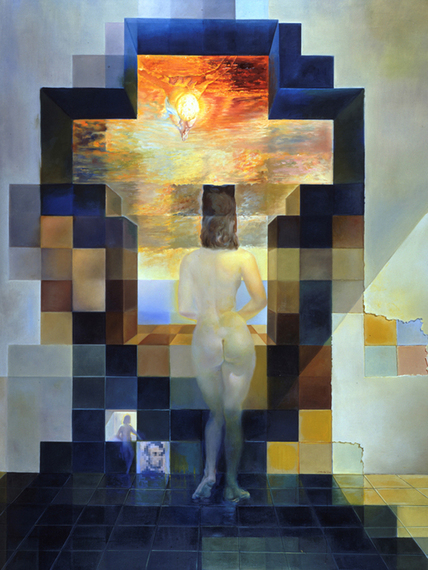Gala Contemplating the Mediterranean Sea Which at Twenty Meters Becomes the Portrait of Abraham Lincoln (Homage to Rothko), 1976
© Salvador Dali. Fundacion Gala-Salvador Dali, (Artist Rights Society), 2014 / Collection of the Salvador Dali Museum, Inc., St. Petersburg, FL, 2014.
A challenging task for many art exhibitions is to provide visitors with an intellectual experience that complements their visual experience. Marvels of Illusion, at The Dali Museum in St. Petersburg, FL, succeeds in achieving both. In this conversation, Dr. Hank Hine, Executive Director at The Dali Museum talks to us about Marvels of Illusion and how scientific developments influenced Dali's work.
Lilia Ziamou: Marvels of Illusion, currently on view at the Dali Museum, aims at both an optical and intellectual visitor experience. How did the theme for the exhibition come about?
Hank Hine: The exhibit was driven by a marvelous social media concept from Dali Museum Trustee and advertising impresario, Jeff Goodby. His team at Goodby, Silverstein & Partners conceived of a way of putting our visitors, both actual and virtual, into one of Dali's paintings, a double image portrait of Lincoln. The app removes Abraham Lincoln's face from Dali's work and replaces it with our visitor's. An iPad is set up in the gallery to take portraits and, as well, people can us their iPhones from anywhere in the world. The new artwork, with the visitor's face is projected in the gallery, photographed and sent to your own website. Once this terrific piece of technology was proven, we gathered other Dali works that involved optical and visual illusions to make a festival of illusions - thought provoking and delightful.
Lilia Ziamou: What do we know about Dali's mindset that influenced the creation of Gala Contemplating the Mediterranean Sea Which at Twenty Meters Becomes the Portrait of Abraham Lincoln (Homage to Rothko)?
Hank Hine: Dali was fascinated by the discoveries of avant-garde science. The discovery of the subconscious by Freud, Max Planck's theorems that entangle the observer with what is being observed, Heisenberg's uncertainty principle - each of these recast our sense of how the world works. Dali ached for a religious connection to the world and he found that connection in the metaphysics that science provoked. Was the viewer as much in charge of making sense of a painting as the artist? Was it possible that something could be in two places at the same time. Science allowed for that and Dali rebuilt his faith, and his art, around these possibilities.
Lilia Ziamou: What are some of the other highlights of the exhibition?
Hank Hine: Another interactive piece is based on an anamorphic distortion of a skull that is painted on the floor. The image assembles as a skull in an immense convex mirror in the center of the room. Our friends at the Ringling Museum loaned us a painting by the 16th century Italian Arcimboldo who painted portraits of Emperor Maximilian's courtiers as collages of fruits, nuts, and vegetables. From a distance it looks like a nobleman and as you approach his face decomposes as zucchinis, apples and wheat. The exhibit is great fun, but has a deeply serious side. We learned that Dali's double images are well known to neurologists, and writers for the Scientific American have used them to study the science of perception. We hired these writers to create detailed panels that explain how the mind processes visual information and how much the illusionism in art can tell us about the human brain.
Lilia Ziamou: Can you elaborate on Dali's "Paranoia Critical Method"? How was it influenced by the scientific theories of the time such as Heisenberg's uncertainty principle?
Hank Hine: Dali's "Paranoiac Critical Method" has received lots of attention. It is a difficult name for a theory that is really very simple. Critical methods are those methods that look objectively and comparatively at their subject. The Greek origin of the word paranoia means the mind standing beside itself. In other words, Dali's method was to look at the world in a new way. When Crick and Watson discovered that DNA had an amazing structure of interlocking helixes, Dali said, "Aha!" Crick asked what he meant. Dali explained that the presence of such a beautiful structure in every living thing proved the presence of the Divine in life. Crick and he became fast friends and Crick spent his last years studying the nature of human consciousness from a scientific viewpoint. We can say that in artistic terms this is exactly what Dali did too.
Lilia Ziamou: What were some of the other scientific developments that are reflected in Dali's work?
Hank Hine: In addition to modern science, Dali was trained in the ancient arts of mixing mineral pigments, oils, and varnishes. He loved geometry and shared with Leonardo da Vinci a love of geometry. He studied proportion and perspective and learned to make a two-dimensional painting look like an actual three-dimensional scene. His technological skill is what allows him to communicate his alternative vision of the world to us.
Marvels of Illusion, curated by Joan Kropf, runs through Sunday, October 12, 2014 at The Dali Museum, St. Petersburg, Florida.

